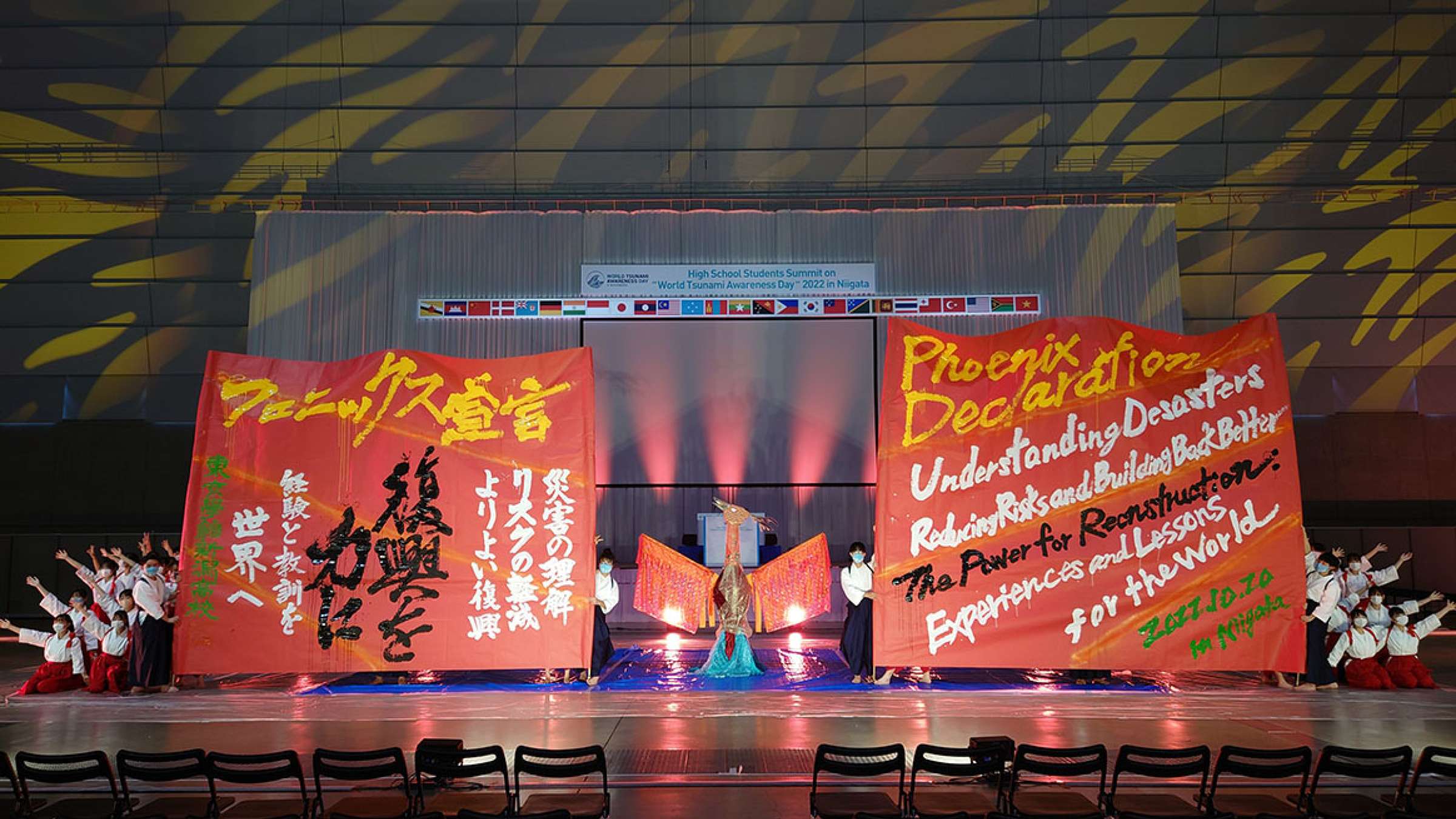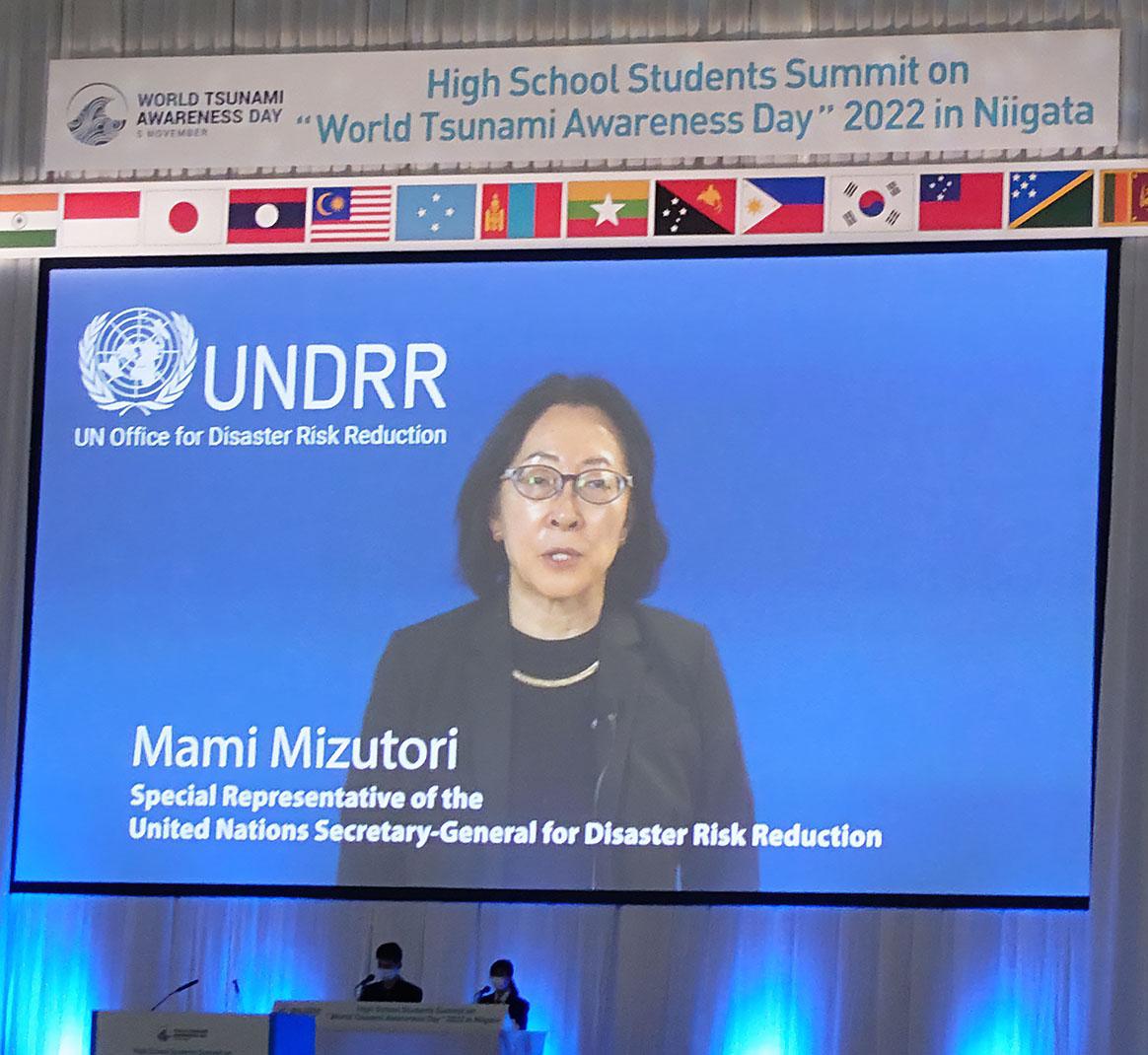Young people for resilience: the global gathering resumes

After a two-year interruption due to the Covid-19 pandemic, students from around the world gathered again this year – both virtually and in person – to discuss, learn from each other, and reaffirm their commitment to disaster risk reduction.
248 students unite around DRR
The High School Students Summit on World Tsunami Awareness Day 2022 was held this year in Japan’s Niigata prefecture on 19-20 October. The Summit’s hybrid format aimed to draw in more young people from across the globe, to foster the growth of new leaders who will play a central role in enhancing the resilience of their communities. The Summit brought together 248 high school students from 26 countries: 174 students from high schools in Japan – including foreign exchange students – plus 74 students from other countries, joining online.
The Summit was organized by Niigata Prefectural Government, Niigata Prefectural Board of Education, Niigata City, and Niigata City Board of Education. It was supported by: National Resilience Promotion Headquarters; Director General for Disaster Management, Cabinet Office of Japan; Ministry of Foreign Affairs of Japan; Ministry of Education, Culture, Sports, Science and Technology; Ministry of Land, Infrastructure, Transport and Tourism of Japan; Japan Meteorological Agency; Organization for Economic Cooperation and Development (OECD); and Economic Research Institute for ASEAN and East Asia (ERIA). The United Nations Office for Disaster Risk Reduction (UNDRR) Office in Japan is a co-organizer of the event.
The first summit was held in Kochi prefecture in 2016, the year after the adoption of the resolution to designate 5 November as World Tsunami Awareness Day (WTAD) at the UN General Assembly in December 2015. In 2017, the High School Students Islands Summit on WTAD was held in Okinawa, followed by Summits in Wakayama in 2018, and in Hokkaido in 2019.
Like all other host prefectures of previous summits, Niigata has a history of being struck by a variety of natural hazards such as earthquakes, floods, and heavy snowfall.
Learning, sharing, and planning community action
Over the two days of the Summit, students participated in workshops where they made presentations about what they had learned from their prior research and had discussions to come up their own action plans. The workshops were divided into the following three themes: Understanding disasters and improving your survival abilities, Reducing disaster risks, and Taking steps towards building back better. At the General Meeting on the second day, representatives from each group made presentations to share what they had learned together and their suggestions for action plans to support their own communities.
While the online participants could not join the in-person study tour, those who did join gave presentations to share what they had learned with their remote peers.
Empowering children and youth
At the General Meeting on 20 October, the Special Representative of the UN Secretary-General for Disaster Risk Reduction, Ms. Mami Mizutori, said in a video message that young people should be empowered to become agents of change .

Addressing the opening ceremony, Mr. Toshihiro Nikai, Advocate for World Tsunami Awareness Day and Member of the House of Representatives, encouraged the participating students to share what they have learned from the Summit with as many people as possible – as this could save their friends.
“This is the reason why we call you, as youth ambassadors for World Tsunami Awareness Day, to protect precious lives in your countries,” he said.
Taking the lead in raising awareness
The two-day summit was concluded with the adoption of the Niigata Phoenix Declaration. This Declaration highlights important actions they have identified together from the workshops and discussions to improve their own ability to survive, to reduce risks, and to build resilient communities.
The declaration concluded with a commitment to raising awareness and understanding of hazards:
Upon the adoption of the declaration, the Student Chairpersons of the Summit, Mr. Bunou Otokawa (2nd grade of the Niigata Prefectural Niigata High School) and Ms. Chiharu Seki (2nd grade of the Niigata Meikun High School) emphasized the importance of their follow up actions by saying “we believe that we can fulfil the purpose of this declaration by implementing faithfully the action plans made by us.”
Despite the physical distance separating them, the students were able to actively interact online during the two-day event, deepening the kizuna – bonds – between their countries, and paving the way to work together for disaster risk reduction and resilience for the future.
Students participated from Brunei Darussalam, Cambodia, China, Denmark, Fiji, Germany, India, Indonesia, Japan, Laos, Malaysia, Micronesia, Mongolia, Myanmar, Papua New Guinea, Philippines, Republic of Korea, Samoa, Solomon, Sri Lanka, Thailand, Tonga, Turkey, United States of America, Vanuatu, and Viet Nam.
Is this page useful?
Yes No Report an issue on this pageThank you. If you have 2 minutes, we would benefit from additional feedback (link opens in a new window).